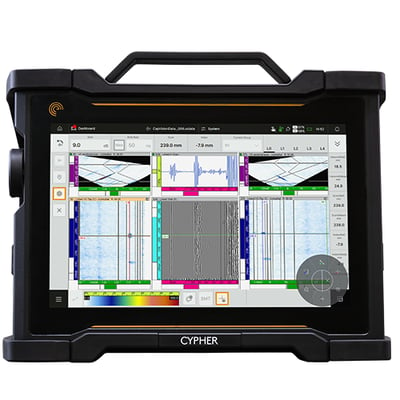Le contrôle traditionnel par courants de Foucault (ECT) est déjà largement utilisé dans l'industrie de la défense pour inspecter les trous de boulons et les fixations dans le fuselage des avions. La plupart des inspections sont effectuées à l'aide de sondes à élément unique, semblables à des crayons, utilisées pour détecter de petites fissures autour des fixations. Par rapport aux inspections visuelles telles que le ressuage ou le contrôle magnétoscopique, l'ECT offre des enregistrements de données numériques, des inspections à travers des revêtements minces et ne nécessite pas l'utilisation de produits chimiques consommables. Toutefois, le fait que l'ECT ne soit pas codé et repose entièrement sur le balayage manuel du technicien entraîne une forte dépendance de l'utilisateur à l'égard de cette technique. Elle rend également difficile l'analyse et l'audit a posteriori, car les fichiers de données ne contiennent aucune position ou localisation géométrique à laquelle se référer.
Le réseau à courants de Foucault s'appuie sur les avantages de l'ECT en offrant la même résolution et les mêmes performances pour la détection des petits défauts, mais il introduit des balayages codés en un seul passage qui suppriment la plus grande partie de la dépendance de l'opérateur et facilitent l'analyse des données. L'affichage des données sous la forme d'une carte couleur complète (C-scan) fait toute la différence lorsqu'il s'agit d'identifier les indications de fissures. Les solides capacités de l'ECA pour l'inspection des structures aéronautiques ont été prouvées à maintes reprises, avec cet exemple d'inspection de longerons et celui-ci d'inspection de trous de rivets.

Outre l'inspection des rivets et des trous de fixation, le personnel militaire chargé des essais non destructifs est souvent confronté à des défis uniques qui ne peuvent être relevés par aucune technologie autre que l'ECA. L'un des meilleurs exemples de cette situation est décrit par la Royal Australian Air Force (RAAF) dans cet article de l'Australian Defense Business Review. Les efforts de la RAAF pour surveiller la corrosion trouvée dans les tuyaux de ravitaillement en vol l'ont amenée à travailler en collaboration avec Eddyfi Technologies pour développer une nouvelle solution et méthode d'inspection basée sur l'ECA. L'inspection visuelle ne pouvait fournir aucune information en raison du revêtement extérieur des tuyaux, et le contrôle traditionnel par courants de Foucault n'était pas en mesure de détecter la corrosion de manière fiable en raison de la structure complexe du tuyau lui-même. En comparaison, la méthode ECA a permis de détecter la corrosion de manière fiable et à un stade précoce de la propagation, ce qui a finalement permis de prolonger la durée de vie des tuyaux et de réduire les coûts associés à leur réparation et à leur remplacement. Comme l'indique l'article, "l'introduction de cet équipement a permis de faire progresser les nouvelles applications de cette technologie dans la communauté de la défense et de l'aviation civile".
L'inspection des turbines d'avion est un autre exemple de la contribution de l'ECA à la protection de l'aviation militaire. Les disques et les pales des turbines d'avion ont beaucoup de points communs avec ceux des turbines à gaz utilisées dans l'industrie de la production d'énergie, si ce n'est qu'ils sont généralement plus petits. Toutefois, les principes fondamentaux de l'ECA pour la détection des fissures à la surface des pales ou dans les dentelures à leur racine restent les mêmes. De petites sondes rigides avec un réseau de bobines suivant la géométrie exacte des dentelures peuvent être adaptées spécifiquement au profil en "queue d'aronde" pour assurer la détection de fissures inférieures à 0,75 millimètre (0,03 pouce) de long par 0,38 millimètre (0,01 pouce) de profondeur, n'importe où sur la surface. Les projets passés ont montré que l'ECA reste inégalée pour ce type d'inspection, tant en termes de rapidité que de fiabilité de la détection.

Enfin, les essais non destructifs pour la défense n'ont pas besoin de présenter de petites géométries telles que des trous de rivets ou des dentelures de pales pour risquer de développer des fissures de fatigue ou de la corrosion. Plus d'un projet a impliqué l'inspection de grands cylindres qui devaient être contrôlés à l'aide de techniques non destructives pour la détection de fissures de la taille d'un millimètre, à la fois sur leurs surfaces externes et internes. Avec sa large couverture de 200 millimètres (8 pouces), son codeur intégré et sa flexibilité mécanique sur une large gamme de diamètres, la sonde à réseau Spyne™ est idéale pour inspecter la surface externe de ces cylindres en quelques minutes. Pour la surface intérieure, l'équipe de produits personnalisés d'Eddyfi Technologies a mis au point ce que l'on appelle le "scanner X", qui utilise la même sonde flexible que le Spyne, mais comprend un dispositif de centrage robuste et codé qui pousse la sonde en contact étroit avec la surface. Trois jeux de roues à ressort assurent la stabilité et l'alignement de la sonde pendant le balayage. En quelques minutes, la surface intérieure des cylindres peut être entièrement inspectée, les données du balayage C analysées et les indications rapportées.

Toutes ces solutions ECA sont compatibles avec l'Ectane® 3, mais surtout avec le Reddy®, doté d'un puissant logiciel embarqué, d'un écran tactile LCD de 264 millimètres (10,4 pouces), de batteries d'une autonomie de 8 heures et d'une grande portabilité. Cet outil polyvalent ouvre la voie à de nombreuses possibilités d'inspection des aéronefs sur les sites militaires et au-delà.

Le secteur de la sécurité et de la défense joue un rôle important dans la protection de la sécurité publique, et Eddyfi Technologies s'engage à faire sa part en fournissant une technologie fiable pour aider à assurer le fonctionnement sécuritaire de ses actifs aériens, terrestres et maritimes. Vous avez une application similaire ? Contactez nos experts et restez à la pointe de l 'actualité.





